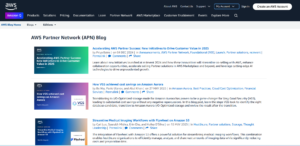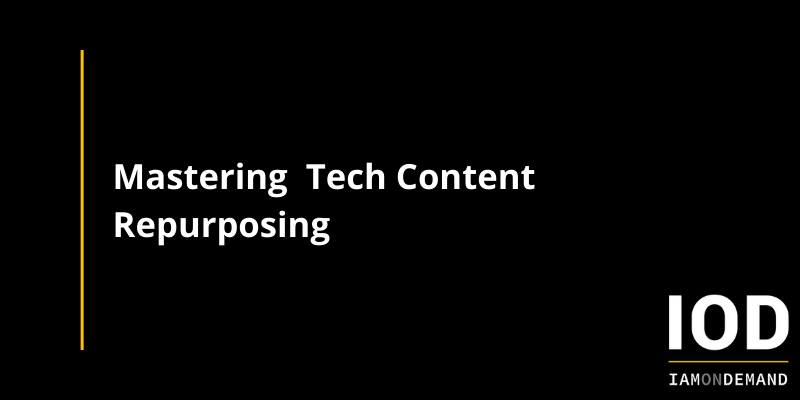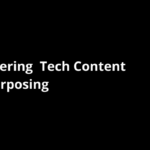Recently, one of our large enterprise customers asked us to join a roundtable of their vendors and marketing pros to discuss goals for the next year. In one of the discussions, an SEO consultant they hired raised an idea:
“Just take this blog post and make it a nice PDF with a header and footer; then you’ll have another asset to use.”
He was so confident, and it seemed like this is what he suggested to his customers regularly. I had always known that marketers do that, but I will never forget this moment because the only thing that came to my mind was that I would never recommend or hire this vendor.
Creating exceptional tech content is challenging for most marketing teams. Targeting use cases, interviewing customers and subject matter experts (SMEs), and mastering the balance between try-it-yourself examples and storytelling often throws even the most experienced content marketers for a loop. Plus, the costs to create brand new and original technical content to maintain your content strategy can quickly add up.
Naturally, the difficulties that come with developing tech content make repurposing that content extremely tempting. Many marketers know that reusing content is a great way to get more mileage out of a successful piece of content, but often, they aren’t quite sure how to repurpose this content effectively.
Developers have specific standards for compelling tech marketing content, which can make repurposing technical content seem even more daunting. Thankfully, with the right strategy and fresh eyes, you can easily start expanding your content strategy with content you already have.
Repurposing vs. Repackaging Content
With 38% of organizations claiming updating and repurposing their existing content to be their most successful content strategy tactic, it’s clear why marketers are eager to try this. But many marketers misinterpret content repurposing and end up only repackaging their content instead. It’s important to understand the difference between content repackaging and repurposing to reap the benefits of this strategy.
Content repackaging is presenting your existing content in a new format. One example of effective content repackaging is providing a written transcript on the same webpage as a video interview. This can make your content accessible to multiple audiences who prefer to consume content in different ways.
Meanwhile, an example of ineffective content repackaging is turning a blog post into a branded, gated PDF to collect email addresses, like the SEO in my previous story suggested. In this case, providing the content in a repackaged format doesn’t offer the reader any additional benefit or new information.
While there are benefits to providing your content in new formats, content repackaging rarely helps your organization achieve its goals, because it doesn’t produce new, original, plagiarism-free content. Contrarily, content repurposing is a way to provide your audience more value from your existing content.
Content repurposing is making multiple distinct content pieces for different platforms by leveraging the same source material, allowing you to rapidly scale your content strategy with more affordable content. For example, teams can use information collected during a single podcast interview recording to create multiple blog posts, design infographics, develop social media threads, feature audio and video snippets, and more.
Here are the top strategies your team can use to repurpose your tech marketing content.
1. Use Original Content to Inspire Your Repurposed Content
A single interview, event, or use case can present tons of different angles that can appeal to developers and technically-minded professionals. However, when marketers try to repurpose content from an existing “finished product”—like a blog post or video—they often end up regurgitating the same content into a new format. If your new content feels too similar to the original content piece, it likely won’t help accomplish your content goals.
Instead, focus on creating source material you can leverage for multiple content pieces. Capturing resources like recorded interviews with SMEs or clients, use-case walkthroughs or product demonstrations, webinars, live events, and original research data offers thought leadership and context your marketing team can repurpose into new, original content.
Then, rather than creating one large content piece from these experiences, transcribe the source material and explore how you can expand the ideas covered into multiple pieces of content that target different audiences on different platforms or throughout the sales funnel.
Even if you’ve already created a lengthy ebook or video interview from your source material, don’t try to create new content from this existing asset. Always start by referencing the original source material for inspiration and content. This keeps your perspective fresh and helps you find nuances to dive deeper into that you may not discover from a polished, finished product.
2. Focus on Creating Short, Niche Content
When you start with lengthy source material, there’s a good chance it covers a wide array of related topics. Pulling transcripts of videos or audio and parsing data from the original source makes it easy to note the major themes covered by your SME. From here, you can see which themes you can expand on or break down into smaller, more distinct topics to develop highly targeted content pieces.
As you start identifying distinct topics or themes in your source material, ask yourself these questions to find new angles for content:
- Which audience(s) is interested in this topic?
- How does that audience prefer to engage with your brand’s content?
- How does the topic angle change for audiences on different platforms?
- Is there additional context you could add to make this information more helpful for readers at different knowledge and experience levels?
With these answers in mind, consider which types of content and distribution channels will help you accomplish your content goals.
Varying your content strategy starts by expanding into new topics, but those topics also need to be presented in ways that appeal to your audiences, where they are in the sales funnel, and how they choose to engage with your content.
Research from SEMRush found that 24% of organizations say diversification and creating new content types made a big difference for their content strategy in 2021. By diversifying your content and exploring new content types, you can explore topics in a way that supports multiple audiences with different backgrounds, skill levels, and customer goals.
Check Out Our Latest Posts

Choosing Responsible AI: Comparing LLM Providers on Ethics, Transparency, Safety, and Compliance
In 2018, Amazon created an internal AI engine to find the best job applicants. But they were forced to scrap it right away. The problem?

Amazon Nova Act and the New AI Agent Space: What Enterprises Must Know
Amazon Nova Act isn’t just another toy—it’s a bold move into the emerging world of agentic AI. It signals Amazon’s bet on what comes after

How to Get Published on the APN Blog: A Guide to Content Collaboration with AWS
AWS Partner? Want to get your company featured on one of AWS’s most visible platforms—but not sure how to get past the review wall? The
3. Dive Deep with Supplemental Research
The source material is a great place to start, but it shouldn’t be the end of your research when you’re repurposing content!
One big mistake marketers make when repurposing content is trying to tell the same story from their source material in different ways. Instead, find the different stories in your source material and conduct additional research—including interviews with other internal experts—to fill in the gaps.
No one expects a subject matter expert to present everything they know on a topic in an interview or at an event. Typically, interviews aren’t comprehensive and cover myriad topics on a high level. Supplemental research gives your team the opportunity to dive deeper and enrich your content with context, providing even more value beyond what the original source material offered.
Adding relevant, technical examples is a great way to make your content more engaging and applicable to practitioners. Screenshots, walkthroughs, and code snippets alongside those examples are even better; these elements make your content more actionable for developers who want to try to replicate specific results.
For example, one IOD client came to us with content that wasn’t performing as well as they had expected. Despite targeting specific keywords through their SEO campaign, their content wasn’t ranking or converting. We leveraged our extensive network of experts to add relevant tech examples to make 30 of our client’s articles more impactful. Soon after, their content started ranking on the first page of Google for their targeted keywords.
Adding supplemental research doesn’t just make your repurposed content more interesting. It also gives the reader even more context and insight to support them in the buyer’s journey.
4. Prioritize the Customer’s Journey
It’s crucial to understand where your repurposed content fits in to support your audience’s goals and help them learn more about your product. However, the typical buyer’s journey for a developer isn’t always clear to tech marketers.
Your source material is a great place to discover more information about a potential customer’s thought process. Experts know the context customers need to understand certain technology or technical problems, and those details often come through in interviews, events, and Q&A sessions. Use this information to consider how your repurposed content can move your customer along their journey more smoothly.
Internal linking between related content from the same source material helps your audience follow their curiosity and stay engaged with your content longer. Review the source material to see how the conversation flows from one topic to another; then, you can mimic that flow by adding relevant links to blogs, ebooks, or videos you created from the same source material.
It’s also important to consider how customers are learning about your product and incorporate different forms of media into your content repurposing strategy, too. For example, a Twitter thread based on an interview may compel someone to follow your brand and encourage them to read the blog post on the same subject. In that post, you can then link to marketing content that demonstrates the other features your product is capable of.
When you create these different content pieces, keep the call to action simple and clear, guiding them to the next logical step in their customer journey. This will encourage your audience to stay engaged with your brand longer and help them discover more about your product in a high-value, low-pressure way.
Repurpose Your Tech Marketing Content to Maximize Your Content Strategy
There’s no reason to start at square one with every piece of content you create. Strong source material offers tons of opportunities to create compelling, engaging content that resonates with your audience. By leveraging the great content you’ve already created and following these tips, you can accomplish even more of your marketing goals.
Still, we know creating excellent source material isn’t always easy. At IOD, we specialize in helping organizations make their tech content even more impactful. Our network of industry experts can help you add the supplemental information needed to make your repurposed content stand out. IOD practitioners can even create the source material that inspires your team to start repurposing content!
Start creating impactful, technical content that appeals to your audience. Contact us today.





